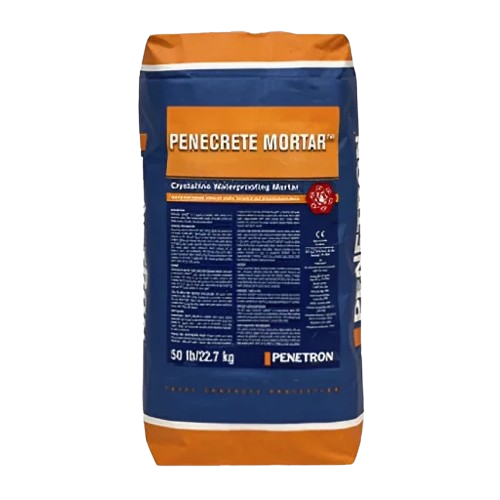Surface preparation:
All surfaces to be patched, repaired or sealed with PENECRETE MORTAR™ must be clean and sound. Cracks should be routed out to a U-shaped configuration, approximately 3/4” (19 mm) wide and a minimum of 3/4” (19 mm) deep. Tie holes should be roughened prior to filling. Spalled and honeycombed areas must be thoroughly cleaned and chiseled back to sound concrete prior to repair. Remove all dirt, cement laitance, form release agents, curing compounds, paints, coatings, etc. by means of wet or dry sandblasting, high pressure water jet or other suitable mechanical means. Surfaces must be well moistened to a dull dampness at the time of application. The concrete should be damp with no wet sheen on the surface.
Mixing:
Routed cracks, coves and non-moving joints: Add water to PENECRETE MORTAR™ until a medium stiff, trowelable consistency is reached. The texture of the mix should be pliable enough to be trowelled into the cracks with some pressure, but not so pliable that it would run out or sag out of the crack. Approximate mixing ratio (by volume) is 4.5 parts powder to 1 part water. Alternatively, 3.4 oz (101 ml) of water to 1 lb (454 g) of PENECRETE MORTAR™ powder.
Tie holes and pointing applications:
Add only a small amount of water. Mixed consistency should be that of “dry earth,” holding a shape when squeezed in your hand but easily crumbled when pressed between fingers. Mix only as much material as can be used within 20 minutes.
Application:
Cracks/seal strips (reglets & coves):
After proper surface preparation and routing to appropriate configuration, prime areas to be patched or repaired with a slurry coat of PENETRON® and while “green” (tacky), fill cavity flush to surface with PENECRETE MORTAR™ in mortar consistency.
Spalled and honeycombed areas:
Prepare surface and chisel back to sound concrete. Prime area to be repaired with a slurry coat of PENETRON®. While still “green” (tacky), apply PENECRETE MORTAR™ in layers of 1/2” (13 mm) not to exceed 2.5“ (6.4 cm). Each layer should be allowed to set long enough that it will leave only a slight indent, approximately 1/16” (1.6 mm) when pressed with a finger. Where possible, the surface of the repair should be packed tightly using a hammer and block of wood.
